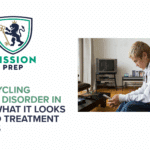Cyclothymia Treatment for Teens: What Cyclothymic Disorder Is and How It Affects Youth

Teen mood swings are often chalked up to hormones or growing pains, but for some adolescents, emotional highs and lows go far beyond typical ups and downs.
Cyclothymia in teens, sometimes called “mild bipolar disorder,” is a real and treatable condition that sits on the bipolar spectrum.¹ It’s marked by persistent mood instability that can disrupt daily life, relationships, and school.
Unlike full bipolar disorder, adolescent cyclothymic disorder tends to involve shorter, less intense shifts in mood.² Still, these fluctuations can leave teens feeling emotionally exhausted and misunderstood. Additionally, parents and caregivers may not recognize early bipolar symptoms, especially if a teen appears highly functional between episodes.
Cyclothymia often develops gradually, which makes mental health monitoring in teens all the more important. With the right support, like daily mood tracking for youth and targeted therapy for bipolar spectrum conditions, teens can regain balance and build emotional resilience.
If you’re concerned that mood swings in a teen go beyond typical hormonal shifts, a mental health professional is available to guide you. This page can also help, exploring:
- What cyclothymia is
- The signs of adolescent cyclothymic disorder in teens
- How to treat cyclothymia
- Cyclothymia vs bipolar disorder
- How Mission Prep can help with youth mood instability treatment

What Is Cyclothymia?
Cyclothymia is a type of mood disorder that causes noticeable shifts in energy, emotion, and behavior.³ It’s considered a “milder” form of bipolar disorder, but this doesn’t mean it feels slight to the teens who live with it. For many, the condition feels like being trapped on an emotional rollercoaster where one minute they’re energized or overly optimistic, and the next they’re withdrawn, irritable, or exhausted.
Cyclothymia dysregulation is often tied to irregular activity in the limbic system, including the amygdala (which processes threat and emotion) and prefrontal cortex (which helps with decision-making and impulse control).¹ Neurotransmitters like dopamine and serotonin may also fluctuate, contributing to mood instability.
Cyclothymia in teens is often overlooked or misunderstood, especially because symptoms may seem like normal adolescent mood swings. But when emotional highs and lows start to interfere with school, friendships, or sleep, it may be time to explore whether adolescent cyclothymic disorder is the underlying cause.
Signs of Adolescent Cyclothymic Disorder in Teens
Cyclothymia can be tricky to recognize in young people, especially since adolescence already comes with its fair share of emotional ups and downs. However, with cyclothymia, mood changes tend to be more intense, frequent, and disruptive than typical teenage shifts.
These emotional highs and lows in teens often don’t last long enough to meet the criteria for bipolar disorder, but they can still cause real distress. Symptoms may show up as patterns that seem unpredictable or confusing, especially when teens cycle quickly between feeling on top of the world and suddenly withdrawn or irritable. Research also shows that cyclothymic patients are at higher risk of suicide.⁴
The following signs of youth mood instability may point to adolescent cyclothymic disorder:
- Frequent mood swings that feel extreme, often without a clear trigger
- Episodes of unusually high energy or optimism, followed by periods of low motivation or sadness
- Irritability that alternates with cheerfulness, sometimes within the same day
- Periods of impulsive or risk-taking behavior, such as reckless spending, arguments, or skipping school
- Trouble sleeping, such as insomnia during “up” phases or oversleeping during low ones
- Shifting self-esteem, such as feeling confident and capable one week and hopeless the next
- Struggles maintaining routines, with energy and focus levels that vary
- A sense of internal chaos, often described by teens as “never feeling steady” or “too much happening in my head”
If these signs are showing up regularly, it may be time to explore whether cyclothymia in teens is at play, and how early support can help restore emotional stability.
How to Treat Cyclothymia
When it comes to treating cyclothymia in teens, the goal is to smooth out the emotional rollercoaster and help young people feel more stable, safe, and in control. Because cyclothymia sits on the bipolar spectrum, treatment focuses on both managing mood symptoms and preventing them from escalating over time. With early support, teens can learn to regulate emotions more effectively and build resilience that lasts into adulthood.
The following are some of the most common and effective treatment approaches:
1. Talk Therapy (Psychotherapy)
Cognitive behavioral therapy (CBT) and dialectical behavior therapy (DBT) are often used to help teens understand their emotional patterns. As a result, they’re better able to challenge unhelpful thoughts and develop skills to manage impulsive behaviors and low moods.⁵
2. Mood Stabilizing Medications
In some cases, health providers may recommend a mild mood stabilizer to prevent extreme highs and lows. Medication is usually paired with therapy and always tailored to each teen’s needs.⁶
3. Psychoeducation for Teens and Families
Learning about adolescent cyclothymic disorder together helps reduce shame, increase self-awareness, and build a shared language for what’s happening. This makes it easier to manage mood swings in youth as a team.
4. Daily Mood Tracking
Using apps or journals to track feelings, sleep, energy levels, and triggers can help teens spot patterns and early warning signs, as well as stay more grounded. Daily mood tracking for youth also helps clinicians personalize care.
5. Lifestyle Support
Stable sleep routines, regular exercise, and balanced nutrition all play a big role in mental health monitoring for teens.⁷ These habits help regulate the body’s stress response and support more balanced brain chemistry.
While cyclothymia in teens can be disruptive, the right treatment plan gives teens the tools to feel steadier, understood, and hopeful about the future.
Cyclothymia vs Bipolar Disorder
Cyclothymia and bipolar disorder exist on the same spectrum, but they’re not the same thing.⁸ The differences come down to intensity, duration, and disruption. Think of cyclothymia as a milder chronic form of mood fluctuation disorder. It’s one that still affects daily life, but without the extreme highs and deep crashes typically seen in full bipolar episodes.
The following is how cyclothymia vs bipolar disorder compare:
- Mood intensity: Teens with cyclothymia experience emotional highs and lows that are noticeable but not as severe as those in bipolar I or II. They might feel unusually energetic for a few days or low and irritable for a stretch, but these shifts don’t typically reach the level of full-blown mania or major depression.
- Duration and pattern: Cyclothymia in teens involves a long-term pattern of mood instability (lasting at least a year), with frequent ups and downs.⁹ Bipolar disorder usually includes distinct episodes of mania, hypomania, or depression that last longer and are more disruptive.
- Functioning: While both can affect school, relationships, and self-esteem, cyclothymia in teens may fly under the radar for longer because symptoms are milder. Further, teens with cyclothymia often learn to mask or push through mood shifts, which can delay diagnosis.
- Diagnosis: A cyclothymic diagnosis in teens often comes after careful observation of persistent emotional highs and lows. It requires ruling out other conditions and tracking how moods change over time. In contrast, while a diagnosis of bipolar disorder is equally comprehensive, it may be more clear-cut due to definable shifts in mood.
Understanding the difference between cyclothymia vs bipolar helps families and providers choose the right support. Both conditions benefit from therapy for bipolar spectrum issues and consistent mental health monitoring in teens, but cyclothymia may respond especially well to early intervention and lifestyle-based support.

Reach Out to Mission Prep for Youth Mood Instability Help
When your teen seems stuck on an emotional rollercoaster, it’s easy to feel unsure about what’s normal and what needs support. Mood swings in youth can come and go, but when they linger, intensify, or affect daily life, they may point to something deeper, like cyclothymia or another mood fluctuation disorder.
At Mission Prep, we work with teens and families to get to the root of emotional highs and lows. Our team understands the nuances of adolescent cyclothymic disorder and how it shows up in school, at home, and in relationships. Our treatment options include therapy for bipolar spectrum conditions to help teens build emotional awareness, develop healthier coping skills, and stay grounded through the ups and downs.
Recovery starts with recognition. If you’ve noticed patterns of unpredictability or persistent mood instability in your teen, you don’t have to wait for a major crisis to take action. With early guidance and daily mood tracking for youth, teens can learn to manage their emotions before patterns become deeply ingrained.
Our team of specialists is committed to helping your teen move toward stability, confidence, and lasting mental wellness. Reach out today to chat with a professional about assessing your teen and helping them get the help they need and deserve.
References
- Bielecki, J. E., & Gupta, V. (2025). Cyclothymic disorder. In StatPearls. StatPearls Publishing. https://www.ncbi.nlm.nih.gov/books/NBK557877/
- Van Meter, A. R., Youngstrom, E. A., Birmaher, B., Fristad, M. A., Horwitz, S. M., Frazier, T. W., Arnold, L. E., & Findling, R. L. (2017). Longitudinal course and characteristics of cyclothymic disorder in youth. Journal of Affective Disorders, 215, 314–322. https://pmc.ncbi.nlm.nih.gov/articles/PMC5512510/
- Perugi, G., Hantouche, E., & Vannucchi, G. (2017). Diagnosis and treatment of cyclothymia: The “primacy” of temperament. Current Neuropharmacology, 15(3), 372–379. https://pmc.ncbi.nlm.nih.gov/articles/PMC5405616/
- Hunter, Y. (2023, June 9). Cyclothymia, the quintessential mood temperament: Ignored or forgotten? Part II: Children and adolescents. Psychiatric Times. https://www.psychiatrictimes.com/view/cyclothymia-the-quintessential-mood-temperament-ignored-or-forgotten-part-ii-children-and-adolescents
- Saccaro, L. F., Giff, A., De Rossi, M. M., & Piguet, C. (2024). Interventions targeting emotion regulation: A systematic umbrella review. Journal of Psychiatric Research, 174, 263–274. https://www.sciencedirect.com/science/article/pii/S0022395624002310
- Van Meter, A. R., & Youngstrom, E. A. (2012). Cyclothymic disorder in youth: Why is it overlooked, what do we know and where is the field headed? Neuropsychiatry, 2(6), 509–519. https://pmc.ncbi.nlm.nih.gov/articles/PMC3609426/
- Wickham, S.-R., Amarasekara, N. A., Bartonicek, A., & Conner, T. S. (2020). The big three health behaviors and mental health and well-being among young adults: A cross-sectional investigation of sleep, exercise, and diet. Frontiers in Psychology, 11, 579205. https://www.frontiersin.org/journals/psychology/articles/10.3389/fpsyg.2020.579205/full
- Van Meter, A., Goldstein, B. I., Goldstein, T. R., Yen, S., Hower, H., Strober, M., Merranko, J. A., Gill, M. K., Diler, R. S., Axelson, D., Ryan, N. D., Keller, M. B., & Birmaher, B. (2018). Parsing cyclothymic disorder and other specified bipolar spectrum disorders in youth. Journal of Affective Disorders, 238, 375–382. https://www.sciencedirect.com/science/article/abs/pii/S0165032718301812
- Smith, J. (2016, May 17). Cyclothymic disorder (cyclothymia): Symptoms, causes, and treatments. Psych Central. https://psychcentral.com/disorders/cyclothymic-disorder-cyclothymia



















